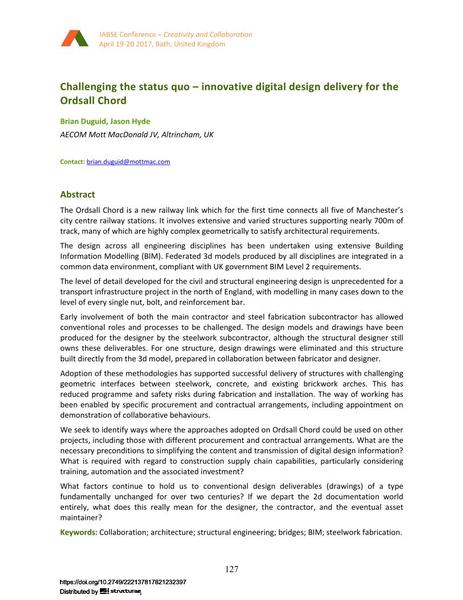Challenging the status quo – innovative digital design delivery for the Ordsall Chord

| Autor(en): |
Brian Duguid
Jason Hyde (AECOM Mott MacDonald JV, Altrincham, UK) |
|---|---|
| Medium: | Tagungsbeitrag |
| Sprache(n): | Englisch |
| Tagung: | IABSE Conference: Creativity and Collaboration – Instilling Imagination and Innovation in Structural Design, Bath, United Kingdom, 19-20 April 2017 |
| Veröffentlicht in: | IABSE Conference Bath, April 19-20, 2017 |
| Seite(n): | 127-134 |
| Jahr: | 2017 |
| DOI: | 10.2749/222137817821232397 |
| Abstrakt: |
The Ordsall Chord is a new railway link which for the first time connects all five of Manchester’s city centre railway stations. It involves extensive and varied structures supporting nearly 700m of track, many of which are highly complex geometrically to satisfy architectural requirements. The design across all engineering disciplines has been undertaken using extensive Building Information Modelling (BIM). Federated 3d models produced by all disciplines are integrated in a common data environment, compliant with UK government BIM Level 2 requirements. The level of detail developed for the civil and structural engineering design is unprecedented for a transport infrastructure project in the north of England, with modelling in many cases down to the level of every single nut, bolt, and reinforcement bar. Early involvement of both the main contractor and steel fabrication subcontractor has allowed conventional roles and processes to be challenged. The design models and drawings have been produced for the designer by the steelwork subcontractor, although the structural designer still owns these deliverables. For one structure, design drawings were eliminated and this structure built directly from the 3d model, prepared in collaboration between fabricator and designer. Adoption of these methodologies has supported successful delivery of structures with challenging geometric interfaces between steelwork, concrete, and existing brickwork arches. This has reduced programme and safety risks during fabrication and installation. The way of working has been enabled by specific procurement and contractual arrangements, including appointment on demonstration of collaborative behaviours. We seek to identify ways where the approaches adopted on Ordsall Chord could be used on other projects, including those with different procurement and contractual arrangements. What are the necessary preconditions to simplifying the content and transmission of digital design information? What is required with regard to construction supply chain capabilities, particularly considering training, automation and the associated investment? What factors continue to hold us to conventional design deliverables (drawings) of a type fundamentally unchanged for over two centuries? If we depart the 2d documentation world entirely, what does this really mean for the designer, the contractor, and the eventual asset maintainer? |
| Stichwörter: |
Brücken Architektur Tragwerksplanung BIM
|
| Lizenz: | Dieses Werk ist urheberrechtlich geschützt. Der/die Urheber erteilt durch die Veröffentlichung nur das Recht, dieses Werk zu betrachten/lesen und herunterzuladen. Eine weitere Vervielfältigung und Veröffentlichung bedarf der Genehmigung des Urhebers/der Urheber. |
Bauwerke und Projekte
0.1 MB Volltext herunterladen (PDF-Datei)
1.18 MB
- Über diese
Datenseite - Reference-ID
10292838 - Veröffentlicht am:
27.01.2019 - Geändert am:
12.11.2021



